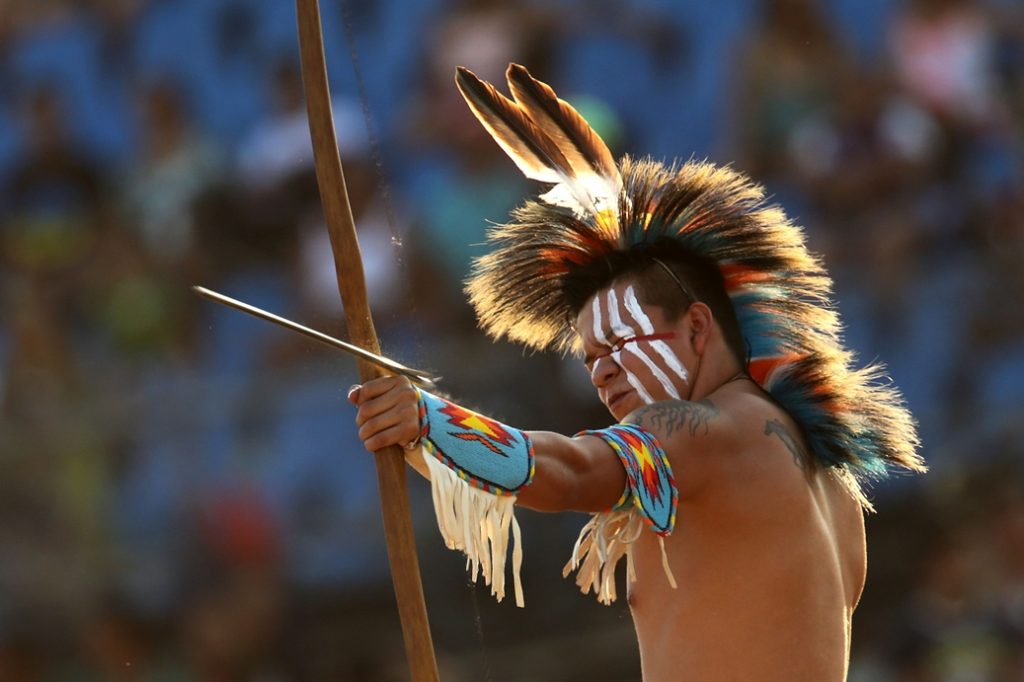Le prime Olimpiadi indigene (guardate le splendide immagini)
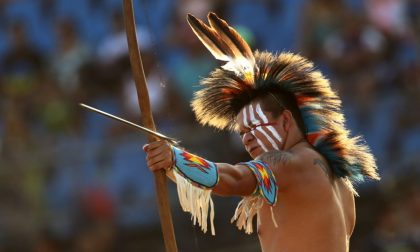
Si svolgono su un terreno di trenta acri, non ci sono sponsor, non ci sono telecamere e nemmeno test-antidoping (non ce n’è bisogno) e non bisogna pagare il biglietto d’ingresso. Eppure sono Olimpiadi in tutto e per tutto, quelle che si stanno svolgendo in questi giorni a Palmas, in Brasile – e non è certo un caso che questa bella novità sia nata proprio nel Paese che nel 2016 ospiterà a Rio le altre, più famose, Olimpiadi. Sono i World Indigenous Games e sono aperti a tutte le tribù indigene del pianeta, oggi purtroppo molto esposte al rischio di estinzione. L’ideatore dell’iniziativa è Marcos Terena, co-fondatore insieme al fratello Carlos della Commissione Intertribale brasiliana (ITC). Terena si è ispirato ai nazionali Jogos dos Povos Indígenas (giochi dei popoli indigeni), nati nel 1999. L’organizzazione dell’evento ha visto coinvolti anche il ministero dello Sport brasiliano e la municipalità di Palmas, che per l’occasione ha creato un’Assemblea Straordinaria per assicurare il regolare svolgimento della manifestazione. Palmas, abitata da molti indigeni appartenenti all’etnia Xerente e capitale della regione di Tocantinia, ha infatti accolto dozzine di delegazioni di tribù provenienti da molti paesi del mondo, dal Canada alla Russia, dalla Neozelanda al Sudafrica agli Stati Uniti, dalle Filippine al Paraguay e alla Mongolia. I grandi assenti sono i Krahô, indigeni brasiliani, che hanno accusato i giochi di sfruttare l’identità india e hanno dunque preferito restarsene in disparte.
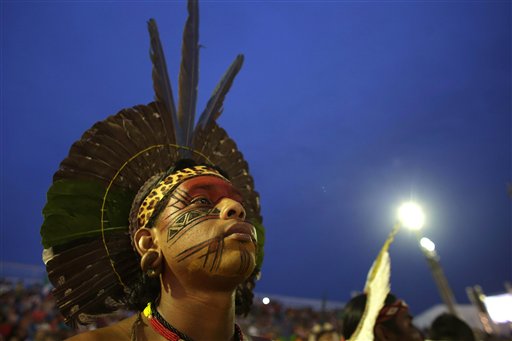
Pataxo Indian from Brazil looks at the field at the World Indigenous Games, in Palmas, Brazil, Sunday, Oct. 25, 2015. Billed as the indigenous Olympics, the games are expected to attract nearly 2,000 athletes from dozens of Brazilian ethnicities, as well as from such far-flung nations as Ethiopia and New Zealand. (AP Photo/Eraldo Peres)
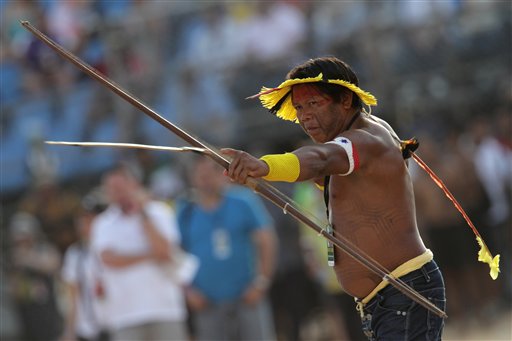
An Brazilian Kayapo Indian takes part in the bow and arrow competition at the World Indigenous Games, in Palmas, Brazil, Monday, Oct. 26, 2015. For many of the nearly 2,000 participants from some 20 countries who converged last week on host city Palmas, a remote agricultural outpost in Brazil's sunbaked heartland, the sports themselves appear to be taking a back seat to what they say really matters, cross-cultural sharing and learning. (AP Photo/Eraldo Peres)
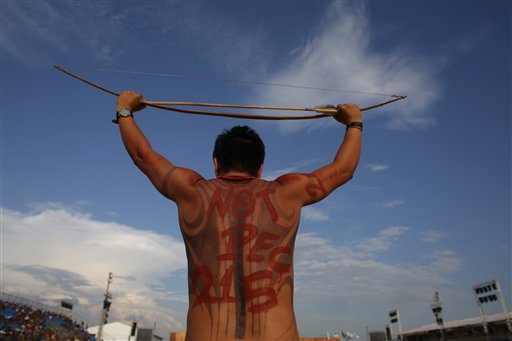
A Pataxo Indian with his painted body holds protest against the proposed amendment to the constitution of the rules of demarcation of indigenous lands, during the World Indigenous Games, in Palmas, Brazil, Monday, Oct. 26, 2015. Organizers billed the nine-day-long event as a sort of indigenous Olympics. But for many of the nearly 2,000 participants from some 20 countries who converged last week on host city Palmas, a remote agricultural outpost in Brazil's sunbaked heartland, the sports themselves appear to be taking a back seat to what they say really matters, cross-cultural sharing and learning. (AP Photo/Eraldo Peres)
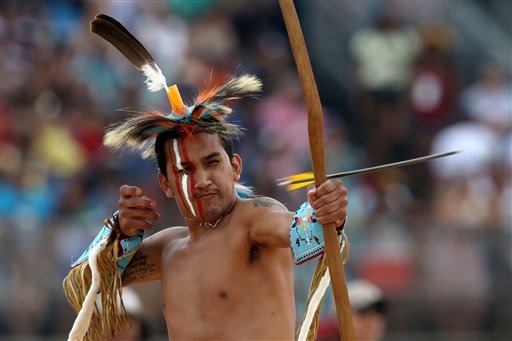
An Indian from the United States takes part in the bow and arrow competition at the World Indigenous Games, in Palmas, Brazil, Sunday, Oct. 25, 2015. Billed as the indigenous Olympics, the games are expected to attract nearly 2,000 athletes from dozens of Brazilian ethnicities, as well as from such far-flung nations as Ethiopia and New Zealand. (AP Photo/Eraldo Peres)
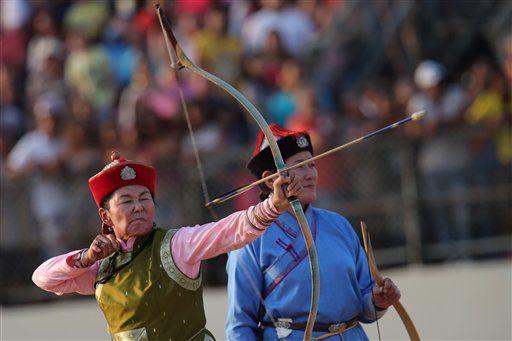
Mongolia indigenous women take part in an archery demonstration during the first day of competition at the World Indigenous Games, in Palmas, Brazil, Saturday, Oct. 24, 2015. Billed as the indigenous Olympics, the games are expected to attract nearly 2,000 athletes from dozens of Brazilian ethnicities, as well as from such far-flung nations as Ethiopia and New Zealand. (AP Photo/Eraldo Peres)
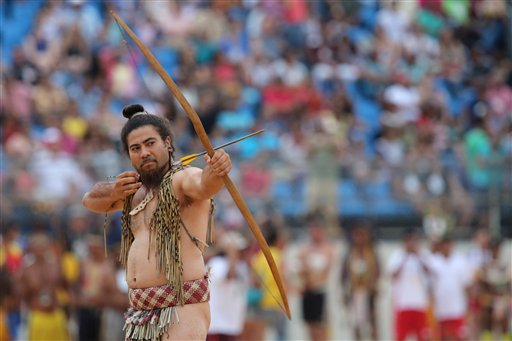
A New Zealand Maori takes part in the bow and arrow competition, at the World Indigenous Games, in Palmas, Brazil, Sunday, Oct. 25, 2015. Billed as the indigenous Olympics, the games are expected to attract nearly 2,000 athletes from dozens of Brazilian ethnicities, as well as from such far-flung nations as Ethiopia and New Zealand. (AP Photo/Eraldo Peres)
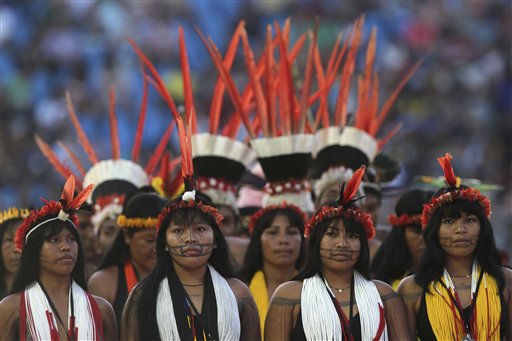
Brazilian Kayapo women perform a ritual dance during the first day of competition at the World Indigenous Games, in Palmas, Brazil, Saturday, Oct. 24, 2015. Billed as the indigenous Olympics, the games are expected to attract nearly 2,000 athletes from dozens of Brazilian ethnicities, as well as from such far-flung nations as Ethiopia and New Zealand. (AP Photo/Eraldo Peres)
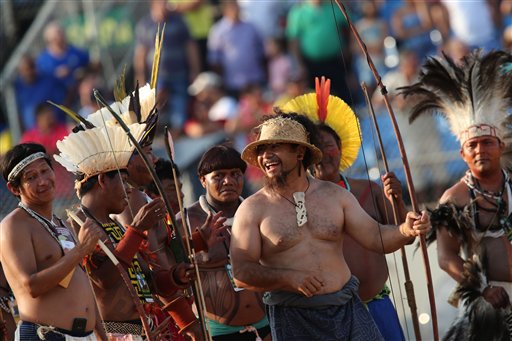
A Maori man of New Zealand, wearing straw hat, smiles at a group of Brazilian indigenous, as they wait to take part in an archery demonstration during the first day of competition at the World Indigenous Games, in Palmas, Brazil, Saturday, Oct. 24, 2015. Billed as the indigenous Olympics, the games are expected to attract nearly 2,000 athletes from dozens of Brazilian ethnicities, as well as from such far-flung nations as Ethiopia and New Zealand. (AP Photo/Eraldo Peres)
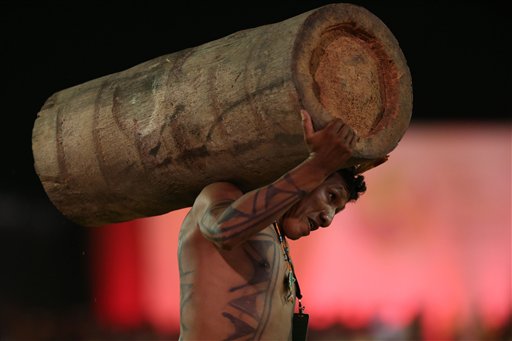
A Brazilian Xavante man carries a log during the first day of competitions of the World Indigenous Games, in Palmas, Brazil, Saturday, Oct. 24, 2015. Billed as the indigenous Olympics, the games are expected to attract nearly 2,000 athletes from dozens of Brazilian ethnicities, as well as from such far-flung nations as Ethiopia and New Zealand. (AP Photo/Eraldo Peres)
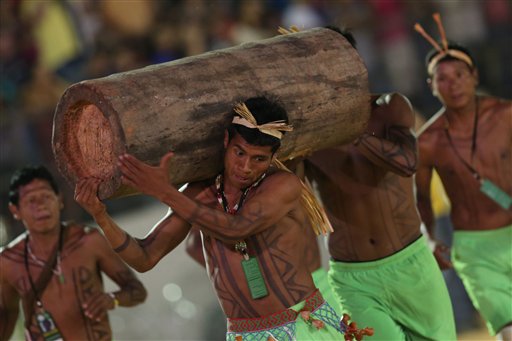
Brazilian Canela men take part in a race carrying logs during the first day of competitions of the World Indigenous Games, in Palmas, Brazil, Saturday, Oct. 24, 2015. Billed as the indigenous Olympics, the games are expected to attract nearly 2,000 athletes from dozens of Brazilian ethnicities, as well as from such far-flung nations as Ethiopia and New Zealand. (AP Photo/Eraldo Peres)
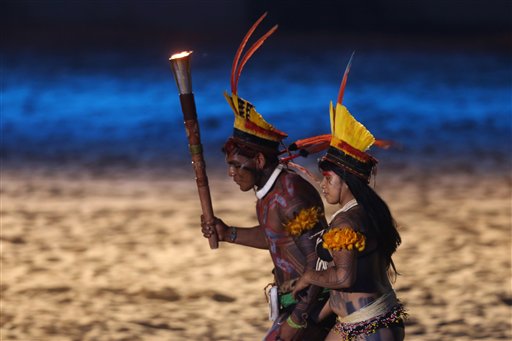
Brazilian Chavantes indigenous carry a torch during the opening ceremony of the World Indigenous Games in Palmas, Brazil, Friday, Oct. 23, 2015. Billed as the indigenous Olympics, the games are expected to attract athletes from dozens of Brazilian ethnicities, as well as from such nations as Ethiopia and New Zealand. (AP Photo/Eraldo Peres)
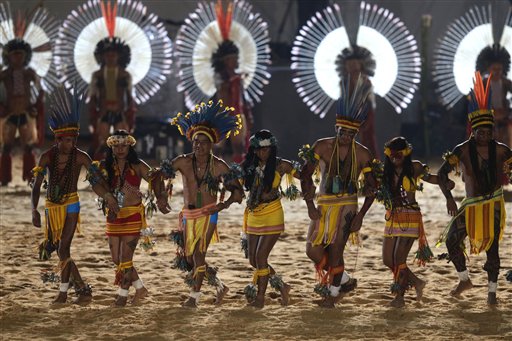
Parisis indigenous from Brazil perform at the opening ceremony of the World Indigenous Games in Palmas, Brazil, Friday, Oct. 23, 2015. Billed as the indigenous Olympics, the games are expected to attract athletes from dozens of Brazilian ethnicities, as well as from such nations as Ethiopia and New Zealand. (AP Photo/Eraldo Peres)
Cosa sono le Olimpiadi indigene. «Em 2015, somos todos indígenas», cioè «Nel 2015, siamo tutti indigeni», è il motto che accompagna i giochi olimpici indigeni, apertisi il 23 ottobre, in presenza del presidente brasiliano Dilma Rousseff e di altri dignitari stranieri, e destinati a concludersi il 1° novembre. Le etnie che hanno aderito sono state settanta e gli atleti sono più di duemila, dai sedici anni in su (non esiste un limite d’età massima). Un’affluenza notevole, che fa ben sperare sul proseguimento della neonata tradizione olimpica tribale. Si pensa, infatti, di organizzare i giochi ogni quattro anni e in Paesi ogni volta diversi, come accade per le Olimpiadi che conosciamo. Le discipline in cui gli atleti si stanno cimentando in questi giorni sono sia occidentali che tipicamente indigene. Ci sono competizioni di football, di canottaggio e di atletica, ma anche di tiro con l’arco, di corsa coi tronchi, di lotta e tiro alla fune. Oltre alle gare vere e proprie, si può assistere anche a dimostrazioni non competitive di sport tradizionali, come lo xikunahati, il calcio indigeno, che si gioca usando la testa al posto del piedi. I promotori dell’Olimpiadi hanno inoltre deciso che tutti gli atleti che partecipano ai giochi riceveranno una medaglia: «Nei nostri giochi non si elegge il campione indiano, non c’è intento commerciale, non vendiamo nulla. La medaglia è per tutti, e va alla qualità della vita», ha affermato Marcos Terena.
Gli organizzatori sono riusciti a mettere d’accordo tutti anche su una questione molto delicata, e cioè l’uso degli strumenti necessari per i vari sport. Ogni etnia, infatti, usa canoe, frecce, archi e lance di diversa grandezza e forma, secondo ciò che prescrive la tradizione. Il capo della delegazione statunitense, David Yarlott, preside del Little Big Horn College del Montana e membro dell’etnia dei Crow, ha affermato che molte tribù considerano gli oggetti che usano come strumenti sacri e dunque non sono contenti, quando si tratta di condividerli con altri. Si è dunque deciso di lasciare scegliere ai partecipanti tra differenti tipi di lance, archi, e via dicendo, messi a disposizione degli atleti dagli organizzatori brasiliani. «Questo per noi va bene, perché fare i controlli all’aeroporto con le lance sarebbe stato un po’ difficile», ha commentato Yarlott.
Non solo giochi, ma anche dibattiti. L’apertura dei giochi è stata preceduta da una tre giorni di festeggiamenti in cui si sono tenuti discorsi e simposi sulle questioni di maggiore interesse per la comunità indigena mondiale, all’interno di una struttura designata a questo scopo e chiamata la “Capanna della Saggezza”, Wisdom Hut. Ma i dibattiti su temi culturali e sociali non sono terminati con l’inizio delle Olimpiadi, anzi. Accanto e oltre alle manifestazioni sportive, è stato previsto un preciso un programma di incontri, in cui ogni gruppo ha potuto mettere sul tappeto i problemi che deve affrontare nel proprio Paese, come quello della malnutrizione, dell’alcolismo e della prostituzione. C’è anche un Forum sociale per i popoli, uno spazio dedicato alle attiviste per le donne indigene e sono previste mostre e lezioni. La maggior parte degli eventi sono gestiti dagli indigeni stessi e, nel complesso, si è istituito un festival interculturale e sociale che, senza retorica, può essere considerato il primo di questo tipo, almeno per numero di etnie rappresentate.
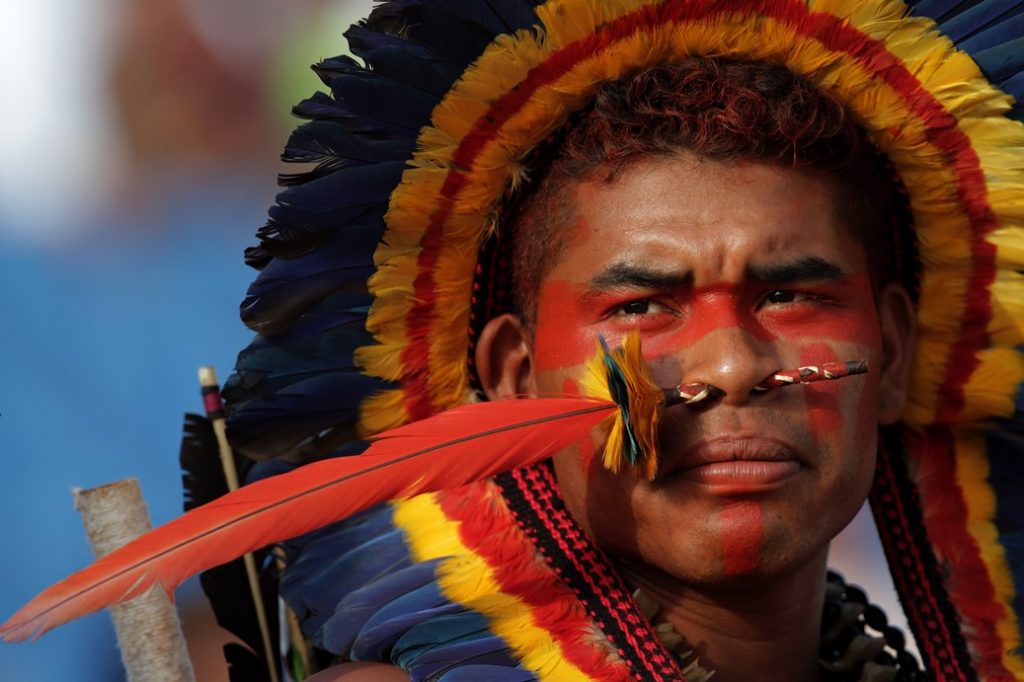
Brazil World Indigenous Games
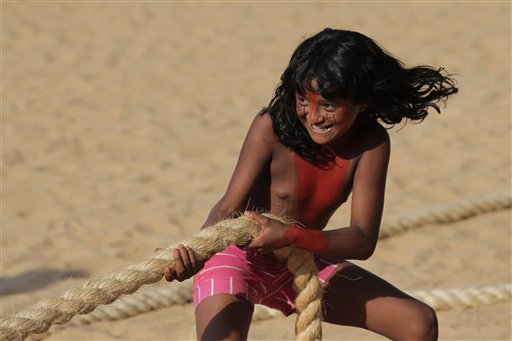
A Gaviao Indian girl plays tug-of-war during the World Indigenous Games, in Palmas, Brazil, Monday, Oct. 26, 2015. The debut competitions were pushed back to Sunday, which saw a surprise upset in the blistering tug-of-war event: New Zealands fierce Maori warriors lost a battle of the titans against the fridge-sized Bakairi people, of central Brazil. (AP Photo/Eraldo Peres)

A Brazilian Bororo Indian is seen in front of the moon at the World Indigenous Games, in Palmas, Brazil, Monday, Oct. 26, 2015. Non-indigenous locals from sleepy Palmas, where the Games are the biggest thing ever to roll into the town during its short 27-year history as the capital of Brazils newest state of Tocantins, got in on the action, too, filling the bleachers and swarming the handicraft fair, getting body paint tattoos and donning headdresses made from macaws. (AP Photo/Eraldo Peres)
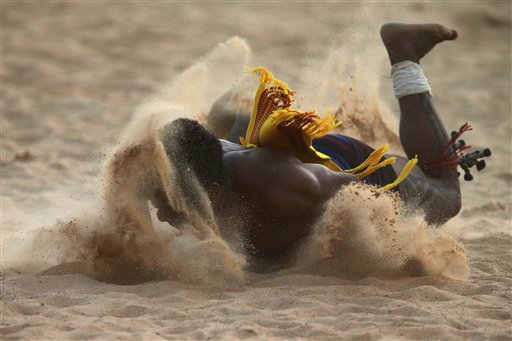
A Brazilian Parisi Indian plays traditional head football during the World Indigenous Games, in Palmas, Brazil, Monday, Oct. 26, 2015. The event, which comes one year after Brazil played host to soccers World Cup and ahead of next years Olympics in Rio de Janeiro, kicked off on Friday. (AP Photo/Eraldo Peres)
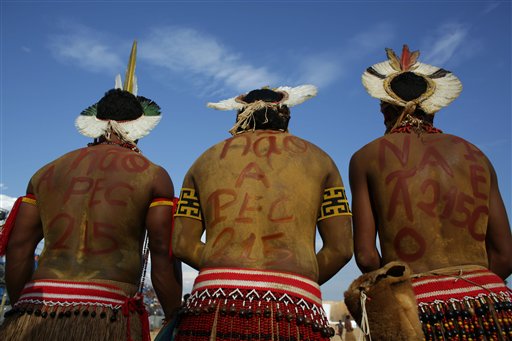
Brazilian Pataxos Indians with their bodies painted, hold a protest against the proposed amendment to the Brazilian constitution that would change the rules of demarcation of indigenous lands, during the World Indigenous Games, in Palmas, Brazil, Monday, Oct. 26, 2015. Native Brazilians represent around two dozen of the continent-sized countrys more than 300 tribes make up the lions share of participants at the Games, and their problems have taken center stage at the event. (AP Photo/Eraldo Peres)
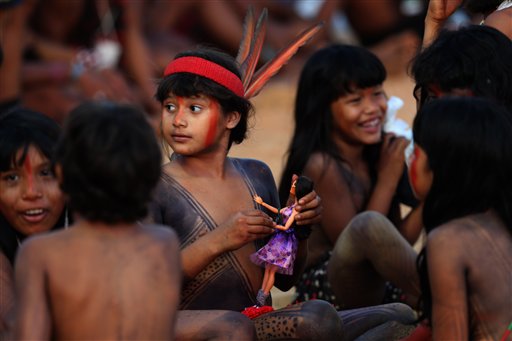
Gaviao children play with a Barbie doll during the World Indigenous Games, in Palmas, Brazil, Monday, Oct. 26, 2015. The Games have been hampered by technical hick-ups and allegations of mismanagement and poor organization. On opening day, construction workers were still busily buzzing away on the installations, and some participants have complained of poor conditions in the indigenous lodgings, which the press was forbidden from visiting. (AP Photo/Eraldo Peres)
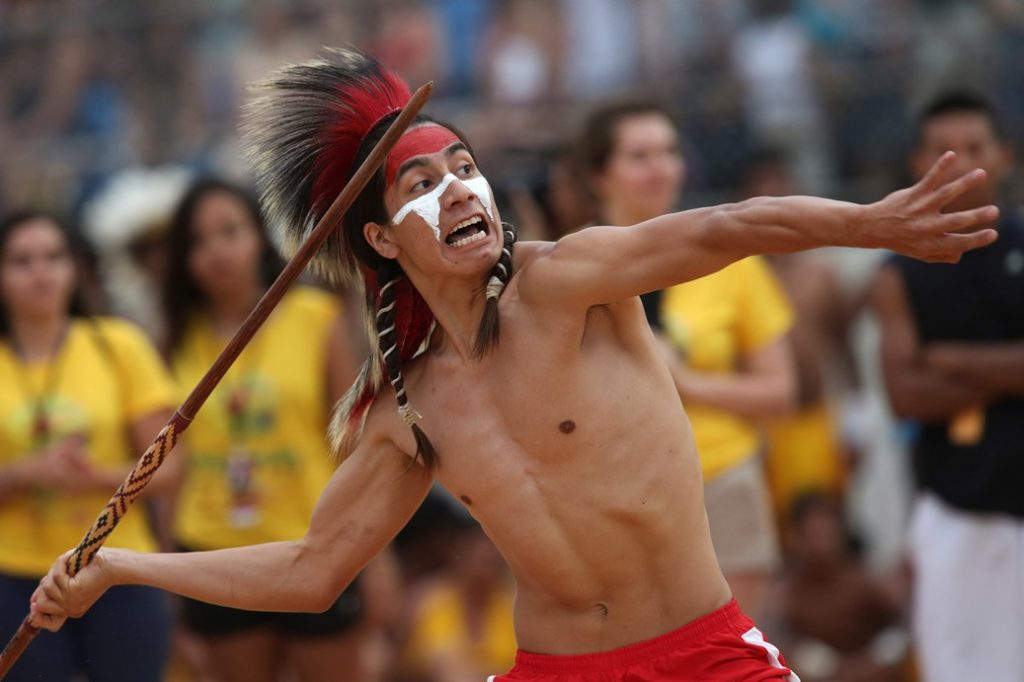
APTOPIX Brazil World Indigenous Games
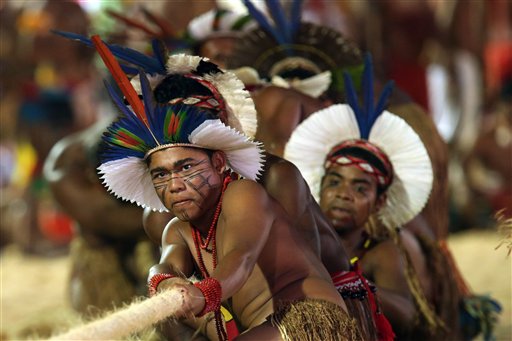
Pataxo Indians from Brazil pull on the rope during the tug of war competition at the World Indigenous Games, in Palmas, Brazil, Sunday, Oct. 25, 2015. Billed as the indigenous Olympics, the games are expected to attract nearly 2,000 athletes from dozens of Brazilian ethnicities, as well as from such far-flung nations as Ethiopia and New Zealand. (AP Photo/Eraldo Peres)
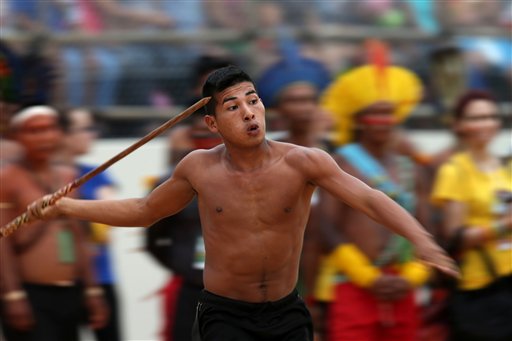
An Indian from Nicaragua takes part in the spear throwing competition at the World Indigenous Games, in Palmas, Brazil, Sunday, Oct. 25, 2015. Billed as the indigenous Olympics, the games are expected to attract nearly 2,000 athletes from dozens of Brazilian ethnicities, as well as from such far-flung nations as Ethiopia and New Zealand. (AP Photo/Eraldo Peres)
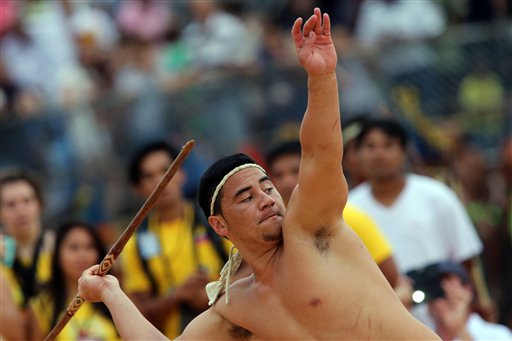
A New Zealand Indian Maori takes part in the spear throwing competition at the World Indigenous Games, in Palmas, Brazil, Sunday, Oct. 25, 2015. Billed as the indigenous Olympics, the games are expected to attract nearly 2,000 athletes from dozens of Brazilian ethnicities, as well as from such far-flung nations as Ethiopia and New Zealand. (AP Photo/Eraldo Peres)
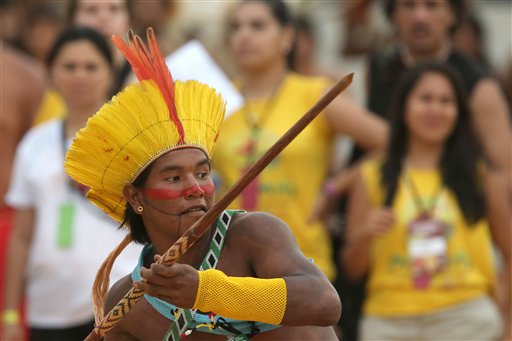
An Brazilian Kayapo Indian takes part in the spear throwing competition at the World Indigenous Games, in Palmas, Brazil, Sunday, Oct. 25, 2015. Billed as the indigenous Olympics, the games are expected to attract nearly 2,000 athletes from dozens of Brazilian ethnicities, as well as from such far-flung nations as Ethiopia and New Zealand. (AP Photo/Eraldo Peres)
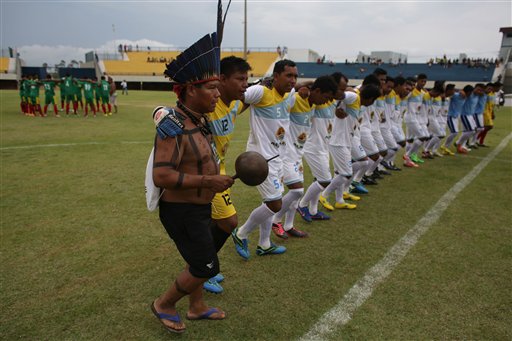
Athletes representing the Xerente tribe perform a ritual dance before the start of a soccer match against the Pataxo tribe, during the World Indigenous Games, in Palmas, Brazil, Friday, Oct. 23, 2015. Billed as the first "indigenous Olympics", the games are expected to attract nearly 2,000 athletes from dozens of Brazilian native tribes, as well as from such far-flung nations as Ethiopia and New Zealand. (AP Photo/Eraldo Peres)
Olimpiadi ecosostenibili. Niente deve andare sprecato, per i popoli più antichi della Terra, anche quando bisogna di far festa e si sarebbe portati a scialacquare risorse e materiali. Le strutture costruite per i giochi, incluse le residenze degli atleti, sono state perciò realizzate con materiali ecosostenibili e riciclabili. Inoltre, sono state piantati centinaia di nuovi alberi per sostituire quelli intagliati per fare le canoe e altro materiale sportivo. «I bianchi non pensano in questo modo. Comprano una cosa, ne comprano un’altra, e poi la buttano nella spazzatura», ha detto Carlos Terena.
L’importanza di stare insieme. Le popolazioni indigene, oggi, sono in genere proprietarie della terra in cui risiedono, ma non delle risorse e per questo motivo sono poverissime. L’avanzata delle città, delle strade e delle ferrovie, inoltre, toglie sempre più spazio a popoli abituati a vivere sparsi in foreste, praterie, boschi. Le sfide che i popoli africani, americani e asiatici devono gestire sono molto simili e riguardano direttamente la sopravvivenza delle loro tradizioni, della loro cultura e lingua. Lo scopo delle Olimpiadi indigene è quello di creare dei legami duraturi di amicizia tra le etnie che vivono ai capi opposti del mondo, legami di solidarietà e di mutuo aiuto. Come ha affermato Reginaldo Tapirapé, un capo dei Tapirapé che vivono nel Brasile centromeridionale: «Dimostreremo che la nostra lingua è viva, che la nostra cultura è viva, che i nostri corpi sono vivi».
